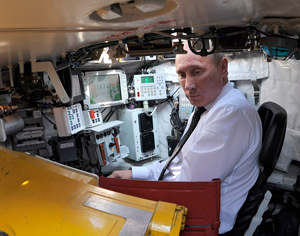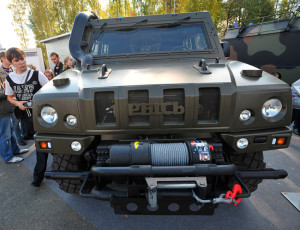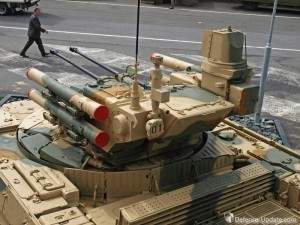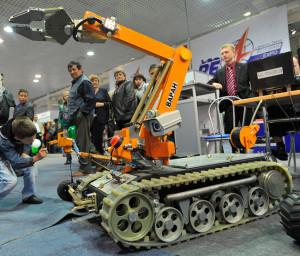

The hottest buzz among visitors planning to attend the Russian Arms Expo at Nizhny Tagil this year will be the the future military modernization of the Russian land forces, and the introduction of next generation of platforms expected by 2015. Expectations are for the debut of the new main battle tank – Armata, a new tracked vehicle and new family of wheeled vehicles (Update: eventually, the new tank was unveiled quietly to Top VIP, inside the ‘presentation pavilion’ reserved for the Terminator-2 BMPT72. This pavilion was oversized for that type of vehicle, and was opened to the press only on the first day of the event. The new tank was hidden from the public eye and is likely to remain secret util it’s planned fielding in 2015). Also likely to be displayed are new unmanned ground vehicles and drones.

RAE at Niznhy Tagil will be an important opportunity for the Russian military industry to display and demonstrate the entire range of their military vehicles, not only those few they were showing at exhibitions overseas, like those in France, Dubai or South Africa. “Customers and defense analysts are expecting to see whether the Russians have progressed (or not) in their military modernization. In these kind of events new deals may be announced, but you don’t expect deals to be signed.” defense analyst and armor expert Christopher Foss said. Foss will take part in a panel on land warfare coinciding with the RAE at Nizhny Tagil.
Unlike Paris, London or Dubai, Niznhy Tagil is remotely located, thus challenging the organizers to provide transportation and accommodations for delegates and exhibitors. However, the facilities provided by military proving ground and modern test track would offer a true attraction for professional visitors. “It took years for DSEI, Eurosatory or IDEF to find the right mix, location and formula for success, I hope that RAE will also find the right combination for success.” Foss commented.

Traditionally the Soviet armored vehicle industry was fragmented, inefficient and redundant. The post Soviet era took this industry through a realization process, with Russian and Ukraine manufacturers offering similar products (T-72, T-80 tanks) and armored personnel carriers. Foss expects the exhibition to provide a showcase highlighting the reorganization in the Russian arms industry and the armed forces. “This consolidation is going on for years. In the past, after the collapse of the Soviet Union, the most advanced products were directed to export, and only few delivered to the Russian military. But in recent years it seems that more sophisticated and advanced systems are developed for and produced by the Russian military.” Foss noted, “The Russian government is spending money on tanks, artillery and armored personnel carriers, something they didn’t do for years.
This is good news for the local industry, as it means more predictable, sustainable funding for R&D and manufacturing, enable the industries to retain important skills that have been lost in the lean years of the past.” All main manufacturers of land combat vehicles will be present at the event and demonstrate combat vehicles on site. These include the tank manufacturer Uralvagonzavod (manufacturing the T-90, BMPT and Armata), tracked vehicle manufacturer Kurganmashzavod (producing the BMP-3 and future Kurganets-25 Armored Infantry Fighting Vehicles), VPK wheeled armored vehicles builder (the manufacturer of BTR-80 and new Boomerang family) and military trucks manufacturer GAZ of Nizhny Novgorod.
Nevertheless, the Russians are not playing alone in this field; they are facing tough competition from China, once Moscow’s biggest customers is also their biggest competitor. South Korea and, to some extent – Ukraine and Singapore are also growing strong in the Russian target markets. All are currently offering a full range of military vehicles, tanks, armored vehicles and artillery.
Cooperation with foreign companies is also an interesting affair. Despite the growth potential in the Russian market, some countries like the US or UK are not likely to sell anything to the Russians, nevertheless, Washington has been a loyal customer of Russian arms, both for evaluation purposes and for its proxies – Afghanistan and Iraq are only part of these.

France and Italy have been doing business with Moscow for some time, and are expected to continue, as long as their national interests are maintained. Thales of France has been providing the Russians with navigation and weapon delivery systems, while Iveco has supplied about 400 light armored vehicles (LMV) to equip the Russian Army. Other Italian vehicles tested by the Russians included Centauro and Freccia armoured vehicles. Following the supply of two Mistral Class flat deck helicopter carriers France is likely to become an attractive contractor of Russian suppliers, delivering systems under industrial participation agreements. Among the French companies exhibiting at the RAE are the French companies Renault, GIAT and Thales.Israel has also developed mixed relations with Moscow, Overall, certain defense exports are approved by the Israel MOD, particularly for homeland security applications. Yet most of the Israeli attention was directed at upgrading ex-Soviet equipment in former Russian republics – Azerbaijan, Uzbekistan and Turkmenistan and Georgia.
Overall, artillery modernization programs represent major opportunities for military modernization in these countries. IMI has also developed a line of Russian-compatible ammunition, including 125mm tank rounds and 122mm rockets. IAI has also been offering a guidance kit for 122mm artillery rockets. Israeli companies have also upgraded different types of combat vehicles, offering thermal sights and remotely controlled weapon systems. IAI also sold Searcher II and Birdeye 400 different Unmanned Aerial Systems (UAS) to the Russians while Aeronautics sold their Aerostars to Azerbaijan, while Elbit Systems delivered its Hermes 450 systems to Georgia. the Israelis were also successful in upgrading attack and assault helicopters.

The Israeli thrust into these markets was not always eyed positively by Moscow, but it seems the situation has been combed down in recent years. Overall, the Russian arms export is aimed at certain sectors of the global market, different from those addressed by Western manufacturers. The slowdown and stagnations that characterize the western and European markets are not really relevant to most of the Russian destinations. In those regions – the Middle East, Central Asia or East Asia, arms races are raging and some of the traditional customers are relying on the Russians to provide all their military needs. However, the landscape of their arms market has changed dramatically in recent years, as they have lost Iraq, Syria and Libya, being some of their biggest customers. The Russians also gained some clients in these years, namely Venezuela, Peru, Malaysia, and Indonesia.
The hottest topic for visitors at RAE will be the the future military modernization of the Russian land forces, and the introduction of next generation of platforms expected by 2015. Unfortunately, unveiling of such platforms has not been confirmed yet. “Expectations are for a new main battle tank, new tracked vehicle and new family of wheeled vehicles, but nothing has been confirmed yet.” Foss noted.

Originally, the Russians intended to maintain the Armata main battle tank somewhat classified, to be displayed privately to top political officials. However, Defense-Update has learned that the tank is likely to appear in public. Its companion, the Kurganets-25 Armored Infantry Fighting Vehicle (AIFV) has also been kept in the black sofar. The Boomerang, replacing BTR-80/82A type 8×8 APCs is likely to participate here in the live demonstration and static display. VPK has also unveiled a version of their 8×8 vehicle fitted with hybrid-electric powerpack, indicating a possible military application of such technology that has been used in the civil and industrial sector for years. The Boomerang defined as a ‘combat wheeled vehicle’, is designed to provide the basis for a family of vehicles including APCs, infantry fighting vehicles, tanks, or self-propelled guns. “This approach, which has become mandatory in the west, will introduce a common chassis offering great savings in supply chain, training, logistical support and life cycle cost.” Foss explains, “Although it is likely that not all these vehicles will be displayed, their appearance at the show will make an important statement that they have overcome the technical and skill gap that held them back in recent years, and are ready to become a reliable supplier of modern land systems.”
Foss expects that absorbing those new platforms by the Russian military will span over more than a decade and cost huge amounts. “That’s why the Russians need increased exports to offset their R&D and manufacturing costs, streamlining production lines with more efficient volumes.” He added.

Being the latest tank to be introduced into the market in recent years, the Armata is expected to attract much attention and debate. “While the demand for tank is not growing, we are not going to see the tanks disappear in the foreseeable future.” Foss said, “The tank is still the most versatile, survivable and mobile land combat platform, carrying an effective direct fire weapon and useful sensors. Improvements we should see in the future should address better deployability through weight reduction, as the infrastructures in many parts of the world cannot sustain vehicles weighing 60 – 70 tons vehicles.“
Another unique capability introduced by the Russians is the ‘The tank support vehicle’, also known as BMPT or Terminator. “The BMPT is currently undergoing a third round of improvement.” Foss noted, “This combat vehicle that has evolved from the lessons of the Chechnya War has not been successful in export markets, nor was it procured by the Russian military, but it provides a highly desirable asset that every tank troop leader would like to have. The main development expected for this third iteration is likely to be in the weapon system composition.”
In the unmanned systems, not much new applications are expected, but the Russians could be showing new robotic mine clearing system, They are also interested in unmanned turrets, although they did not demonstrate such systems up till now.
















